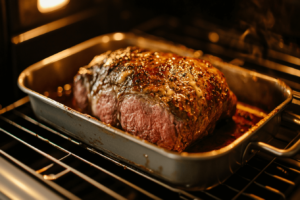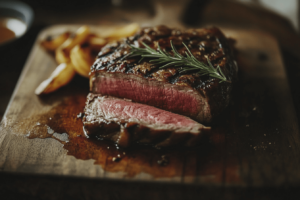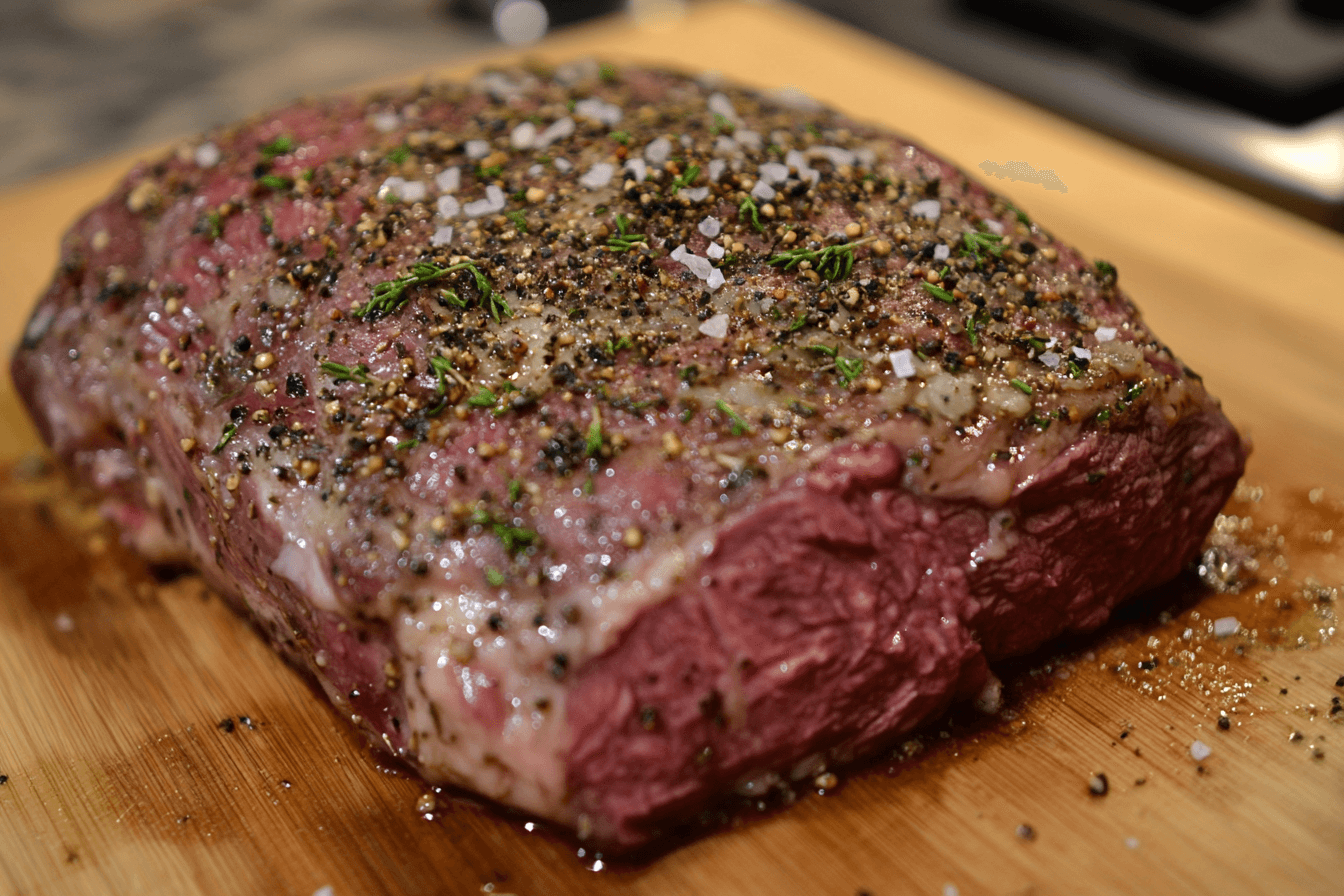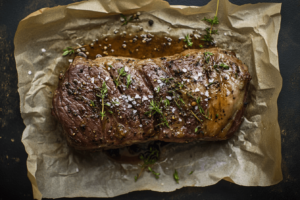Ribeye is often famous for its bold flavor and decadent marbling. Many people think of it only as a great choice for grilling. However, that rich marbling also makes ribeye ideal for a range of cooking methods. One question many cooks ask is, Is ribeye good for roasting? In short, yes! Ribeye performs beautifully when slow-cooked or roasted in the oven. Because it has such natural juiciness, it stays tender and succulent even after extended cooking. This guide will walk you through how to roast a ribeye, what benefits it offers, and a few extra tips for perfect results.
Because you want a great roast, you also want a cut that remains moist. Ribeye delivers, thanks to its generous streaks of fat. Moreover, this cut has an incredible beefy taste. It pairs well with simple herbs and spices or a basic salt-and-pepper rub. If you have been searching for a roast that suits a special family meal or a holiday feast, ribeye should be on your list.
Below, you will discover what makes ribeye a good roasting joint, how to prepare it, and how to serve it. Additionally, you will learn about cooking times, seasonings, and side dish ideas that will enhance every bite. Let’s dive right into the details so you can master roasting ribeye with confidence. Everyone at the table is sure to adore the end result.
Is Ribeye a Good Roasting Joint? Understanding the Cut
Ribeye is a top choice for roasting because of its rich fat content and strong beef flavor. In fact, many chefs consider it the king of roasts. It comes from the rib section of the cow, which is known for producing tender, well-marbled steaks. While it is often cut into single steaks for fast cooking on the grill, this same area can be kept whole and roasted. When cooked at a moderate heat, the fat breaks down slowly, making the meat fork-tender.
Key Characteristics of Ribeye for Roasting
- Marbling: Ribeye boasts noticeable marbling, which helps keep the meat moist. This marbling melts in the oven and adds a buttery quality.
- Flavor: The rib section has intense beefy notes. Additionally, it responds well to rubs or herb crusts without being overshadowed.
- Texture: When roasted, ribeye becomes soft yet still hearty. It is not stringy, and it slices cleanly.
-
Seasoning your roast generously helps lock in flavor.
Because ribeye has a higher fat content, you do not need to add large amounts of extra oil. Often, a light drizzle of olive oil or a thin layer of seasoning is enough. Nevertheless, you can also experiment with infused butter rubs, marinades, or spice blends for extra flavor. Regardless of your approach, the ribeye remains a reliable choice for roasting because it retains moisture so well.
Moreover, this cut is very versatile. You can achieve a crisp outer crust while maintaining pinkness inside if you prefer medium-rare. On the other hand, if you like a more done roast, the fat helps you avoid dryness. This adaptability makes ribeye a solid option for groups with varied preferences. It is definitely a cut worth trying the next time you plan to host a festive meal or special gathering.
Is Ribeye Good for Slow Roasting? The Benefits of Extended Cook Times
Slow roasting a ribeye amplifies its tenderness and depth of flavor. Low temperatures allow the fat to render gradually. As a result, you get a roast that is succulent throughout. This gentle process also prevents overcooking on the outside while you wait for the inside to reach the correct temperature.

Why Extended Cooking Works Well
- Even Heating: A slow roast ensures the internal temperature rises at a steady pace. Thus, the exterior does not become tough or dry.
- Flavor Development: Over time, the connective tissues break down, releasing more natural juices and umami goodness.
- Easy to Control: Slow roasting leaves more room for error. If you lose track of time slightly, you are less likely to ruin the roast.
Yet, slow roasting also requires patience. You will need to plan ahead. It might take longer, but the result can be truly remarkable. Additionally, you can tweak the process. Start with a high-heat sear to lock in juices and then lower the temperature. Or, place it directly into a low-heat oven. Both methods work, though they yield slightly different crusts.
Furthermore, slow roasting is forgiving for those new to cooking large cuts. You do not have to monitor the roast every minute. Instead, you can let the oven do the work while you prepare side dishes or entertain guests. In any case, a ribeye roast cooked this way will fill your home with a mouthwatering aroma. Serve it at your next family gathering to create an unforgettable feast.
Choosing the Right Size and Grade for Roasting a Ribeye
When you decide to roast a ribeye, you first need to pick the ideal size. Commonly, a ribeye roast can range anywhere from two to seven pounds or more. The size you select depends on how many people you plan to serve. Also, think about the grade of beef, as it affects both flavor and tenderness.
Selecting the Grade
- Prime: USDA Prime has the most marbling. It is often the most expensive, yet it provides unmatched juiciness.
- Choice: This is slightly leaner than Prime, but it still has decent marbling and is more budget-friendly.
- Select: This grade is leaner. While you can still roast it, it might need more care to avoid dryness.
Prime offers the best roasting experience, especially if you want a memorable meal. However, Choice can be a great middle ground. Regardless of the grade, keep an eye on marbling. More marbling usually equals more flavor. Thus, even a well-marbled Choice roast can be fantastic.
How Many Pounds Do You Need?
- Two to Four Pounds: Good for a small group of about four people.
- Five to Seven Pounds: Ideal for a bigger gathering or if you want leftovers for sandwiches.
- Seven Pounds or More: Suitable for large events or holiday celebrations.
Bear in mind, a larger cut will require more cooking time. But you can expect a more dramatic presentation at the table. Additionally, leftover ribeye roast can be sliced for sandwiches or used in hearty stews. As a result, you can stretch your roast across multiple meals. Furthermore, a bigger roast also tends to retain moisture better because there is more volume. Hence, do not be afraid to size up if you have a crowd to feed.
Preparing Your Ribeye Roast: Seasoning and Pre-Roast Steps
Before you even preheat the oven, take a few steps to ensure your ribeye roast cooks perfectly. Proper preparation not only boosts flavor but also encourages even cooking. This is particularly important if you plan to roast a thicker or larger cut.
Bring to Room Temperature
Remove the ribeye roast from the fridge about 30 to 60 minutes before cooking. Allowing it to come closer to room temperature helps it cook more evenly. If the meat is too cold, the outside may overcook while the center remains cool.
Pat Dry and Tie
Pat the surface dry with paper towels. This helps the seasoning stick to the roast. If the cut is uneven, you can tie it with kitchen twine. Tying creates a more uniform shape, so your roast will cook at the same speed from end to end.
Season Generously
Salt and pepper form a classic base. However, you can also use garlic powder, onion powder, rosemary, thyme, or any herbs you love. Coat the roast’s surface evenly. Press the seasoning into the meat, so it adheres well.
Optional Marinade or Rub
For extra flavor, consider a simple marinade made with olive oil, herbs, and lemon juice. Alternatively, a dry rub featuring paprika, chili powder, or other spices can lend a tasty crust. Still, the natural flavor of ribeye often shines best with minimal interference. Choose an approach that excites your taste buds.
Lastly, decide whether you want to sear your roast first. A quick sear in a hot skillet adds color and crust. Yet, some prefer to let the oven do the browning. If you do sear, pat the roast dry again before placing it in the oven. This step locks in juices and helps form a rich outer layer.
Is Ribeye Good in the Oven? Mastering the Roasting Process
Ribeye is not only good in the oven—it often excels there. Roasting brings out its savory essence while allowing the fat to melt slowly. The key is to control temperature and cooking time, so you achieve the doneness you prefer.
Oven Temperatures and Cooking Times
- High-Heat Start: You can preheat the oven to around 450°F (230°C), then lower the heat to 325°F (160°C) after 15 minutes. This method sears the outside before letting the inside cook gently.
- Steady Temperature: Another option is roasting at 350°F (175°C) for the entire duration. This results in a balanced cook and a nice crust.
- Slow and Low: You can roast at 275°F (135°C) or 300°F (150°C) for a longer period. This ensures maximum tenderness but yields a softer crust.
Typically, you want to cook your ribeye roast for about 20 to 25 minutes per pound at 325°F (160°C) for medium-rare. Nevertheless, ovens vary, so use a reliable meat thermometer. Insert it into the thickest part of the roast, avoiding bone if there is one.
Target Internal Temperatures
- Rare: 120°F to 125°F (49°C to 52°C)
- Medium-Rare: 130°F to 135°F (54°C to 57°C)
- Medium: 140°F to 145°F (60°C to 63°C)
- Well-Done: 150°F and above (65°C+)
Remove the roast from the oven when it is about 5°F (3°C) shy of your target temperature. Why? Because the roast will continue to cook as it rests. Let it rest for at least 15 to 20 minutes, loosely covered with foil. Resting preserves the meat’s juices and helps every slice stay moist.
Serving the Perfect Ribeye Roast: Sides, Sauces, and Presentation
After roasting your ribeye, it is time to bring it to the table. However, plating and side dishes can elevate the experience further. Ribeye has a robust flavor, so you might pick sides that balance its richness. You can keep it classic or get creative.
Side Dish Inspirations
- Mashed Potatoes: Creamy potatoes pair well with the savory, marbled beef.
- Roasted Vegetables: Carrots, onions, and bell peppers roast at similar temperatures, making them easy to cook together.
- Yorkshire Pudding: If you want a classic approach, these airy puddings are amazing with ribeye roast.
- Green Salad: A crisp, refreshing salad cuts through the fattiness.
Moreover, you can garnish the ribeye roast with fresh herbs like rosemary or thyme. Place a few sprigs on top for an elegant final touch. For a splash of color, add roasted cherry tomatoes or bright steamed vegetables.
Simple Sauces and Gravies
A rich beef gravy often complements a ribeye roast. You can create it by deglazing the roasting pan with beef stock, then thickening with a cornstarch slurry or roux. If you want something lighter, a red wine reduction also works well. Alternatively, a creamy horseradish sauce provides a tangy contrast.
Arrange slices of the roast on a platter alongside your chosen sides. Drizzle a little sauce over each serving, or provide sauce on the side. This approach lets everyone tailor their plate to personal taste. Finally, enjoy the smiles and compliments you are sure to receive as people tuck into this mouthwatering roast.
Cooking Tips for Consistent Results and Flavorful Outcomes
Mastering a ribeye roast takes practice. However, these simple tips will help you achieve success right away. Keep them in mind before, during, and after cooking to ensure consistent, tasty outcomes.
- Use a Thermometer
Always rely on a meat thermometer rather than guesswork. This method ensures you reach your target temperature without overcooking. - Don’t Skimp on Seasoning
Ribeye is flavorful, but it benefits from a liberal coating of salt and spices. Season all sides evenly, including the edges. - Rest Before Carving
After removing the roast from the oven, let it rest. This pause allows juices to redistribute for tender, juicy slices. - Slice Against the Grain
When slicing the roast, identify the direction of the muscle fibers. Cut across them to ensure each slice is as tender as possible. - Adjust for Smaller or Larger Cuts
A tiny roast will cook faster. A giant roast might need extra time. Keep checking the temperature to avoid guesswork. - Be Mindful of Carryover Cooking
Meat continues to cook after you remove it from heat, often increasing by about 5°F. Take that into account so you do not overshoot your desired doneness.
Furthermore, consider garnishing with chopped herbs or finishing salt to bring a fresh note to each slice. You can also serve a little compound butter on top for an indulgent finish. These small touches can transform a simple meal into a memorable one.
Frequently Asked Questions
Is ribeye a good roasting joint?
Yes. Ribeye is a top roasting joint due to its marbling and tender texture. It stays juicy even when cooked for a long time.
Is ribeye good in the oven?
Absolutely. Ribeye cooks beautifully in the oven. It develops a savory crust on the outside while remaining moist on the inside.
Is ribeye good for slow roasting?
Yes, it is. Slow roasting helps break down the fat over time, leading to a melt-in-your-mouth texture. It also ensures even cooking.
Are ribeye roasts good?
Definitely. Ribeye roasts offer rich flavor and softness. They are a popular choice for special occasions or cozy family gatherings.

Conclusion
Ribeye is undoubtedly good for roasting. Its marbling delivers tenderness and flavor that few cuts can match. Whether you opt for a slow roast or a traditional oven method, ribeye remains a strong choice for a standout main course. Additionally, its robust character stands up to a variety of seasonings, marinades, and sides. You can tailor it to suit your taste and that of your guests.
Whenever you ask, Is ribeye good for roasting?, the simple answer is yes! Follow the tips in this guide, and you will impress everyone at the table. Remember to select a quality cut, season liberally, monitor the temperature closely, and let the roast rest before slicing. With these steps, your ribeye roast will turn out succulent and memorable. Serve it with your favorite sides, add a warm atmosphere, and enjoy the wonderful experience that a well-roasted ribeye provides.


